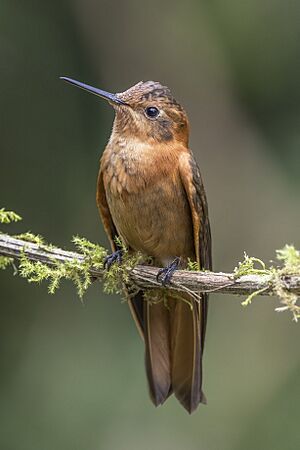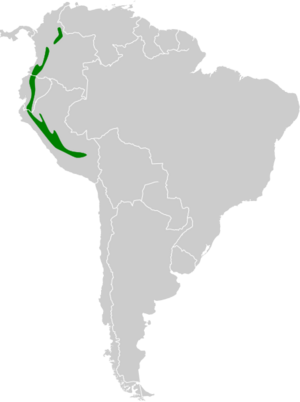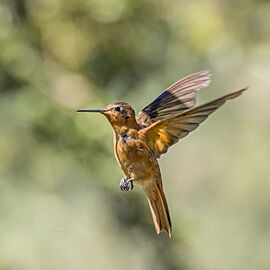Shining sunbeam facts for kids
Quick facts for kids Shining sunbeam |
|
|---|---|
 |
|
| A. c. cupripennis in Colombia |
|
| Conservation status | |
| Scientific classification | |
| Genus: |
Aglaeactis
|
| Species: |
cupripennis
|
 |
|
| Geographical range of A. cupripennis | |
The shining sunbeam (Aglaeactis cupripennis) is a beautiful hummingbird found in the high mountains of Colombia, Ecuador, and Peru. These tiny birds are known for their bright, shimmering feathers that catch the light like a sunbeam. They belong to a group of hummingbirds called "brilliants."
Contents
About the Shining Sunbeam
How Scientists Classify Them
Scientists group living things to understand them better. The shining sunbeam is a type of hummingbird. It has two main groups, or "subspecies," that look a little different: A. c. cupripennis and A. c. caumatonota. In the past, scientists thought there were more groups. Another bird, the purple-backed sunbeam, was once thought to be part of the shining sunbeam family. However, it is now considered its own separate species.
What Does It Look Like?
The shining sunbeam is about 12 to 13 centimeters (5 inches) long. Males weigh around 7.6 to 8.1 grams, and females weigh 6.9 to 7.5 grams. Both male and female birds have a short, straight, black beak. Unlike other sunbeam hummingbirds, these birds do not have any white feathers.
Male and Female Differences
Male shining sunbeams of the main subspecies have a dark brown head and upper back. Their lower back and rump shine with lilac-gold colors, turning silvery green near their tail. Their tail feathers are dark brown to reddish, often with bronze edges. Their throat is reddish with dark gray spots, their chest is a patchy buff color, and their belly is reddish brown. As you go from north to south, the males' undersides become brighter, their heads darker, and their tails redder.
Female shining sunbeams look similar to males. However, the gold and green colors on their lower back and rump are not as bright, or sometimes they are missing. The A. c. caumatonota subspecies is different. It has a shiny amethyst (purple) rump and purplish amethyst feathers near its tail.
Where Do They Live?
The main subspecies of the shining sunbeam lives in all three mountain ranges of Colombia. From there, its range extends south through Ecuador to the La Libertad and Huánuco areas of Peru. The A. c. caumatonota subspecies is found in Peru, from the main subspecies' range south to the Lima and Cuzco areas.
Their Favorite Places to Be
These hummingbirds live in high-altitude areas. This includes places called "sub-páramo" and "páramo," which are grasslands with scattered shrubs and trees. They also live in cloudforests and dry, rocky ridges that have a few trees. You can find them at elevations from 2,500 to 4,300 meters (about 8,200 to 14,100 feet) above sea level.
Shining Sunbeam Behavior
Movement
In Colombia, shining sunbeams move to different elevations depending on the season. This means they travel up and down the mountains throughout the year.
What Do They Eat?
The shining sunbeam eats nectar from flowers. It finds nectar at all levels, from plants on the ground to flowers high in the treetops. They feed from many different plants, including bromeliads, vines, and trees like Embothrium, Puya, and Fuchsia. Male hummingbirds will even protect areas of flowering plants from other birds. These birds also eat small arthropods (like insects or spiders) by catching them in the air.
Reproduction and Life Cycle
The breeding season for shining sunbeams changes depending on where they live. In Colombia, it's from March to September. In Ecuador, it's between February and April. In Peru, it's in November and April, and possibly other times too.
The female hummingbird builds a small, strong cup-shaped nest. She uses moss and spiderwebs, and lines it with soft plant fibers. Sometimes, she decorates the outside with bark or lichen. The nest is usually placed on a branch or a plant growing on a tree, typically 4 to 10 meters (13 to 33 feet) above the ground. Sometimes, it can be as high as 15 meters (49 feet). The female bird lays two white eggs and sits on them for 16 to 18 days. The baby birds leave the nest 24 to 27 days after they hatch.
What Do They Sound Like?
The shining sunbeam's song is made of high-pitched chirping notes. It sounds like "tsip...chew...chew...tseep.....tsip..chew...". Their calls include single, rising "suweet" notes and single, high-pitched "see" notes.
Status of the Shining Sunbeam
The IUCN (International Union for Conservation of Nature) has looked at the shining sunbeam and decided it is a species of "Least Concern." This means they are not currently in danger of disappearing. They live across a large area, and even though we don't know exactly how many there are, their population seems to be stable. They are generally quite common and live in many different types of places. You can also find them in several protected natural areas.




